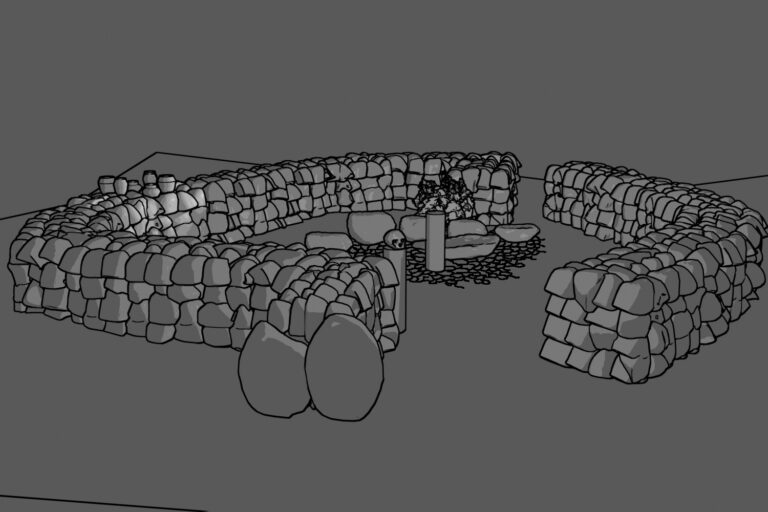
The present Tõnija, Põlluküla, and Rõõsa villages form one settlement complex. An analysis of the location of arable fields shows that the earliest settled points were Rõõsa and the old Tõnija hamlet located a few hundred metres south of the present-day village. The Tuulingumäe-Saunamäe complex sits between these two, but somewhat closer to the later Rõõsa manor, and on the border of former arable fields and marshlands, in the elevated zone abounding in graves and possible cult sites.
Saunamäe was excavated by structured layers and the whole pit covering 170 m2 was opened all at once. As demonstrated by previous excavations of the structures with a profusion of stones, and proven once again at Saunamäe, contemporaneous opening of the whole area is an efficient way to identify collapsed stone structures. Nonetheless, much in Saunamäe remains but a speculation. The schemes drawn during the excavations as well as the findings have yet to be thoroughly examined, so the following interpretations are only preliminary.
Sitting immediately underneath the turf was a fairly recent layer of construction and demolition waste marking the erstwhile hollow which was still remembered by some of the elderly locals. This patch, probably void of stones to begin with, proved to be at the near centre of a stone structure measuring about 4 x 3–4 metres. Another hollow, initially thought to have been caused by subsequent inward digging, was unearthed in the northeastern corner of the pit. As indicated by the regular placement of the surrounding stones, it was most likely part of a structure rather than damage done by excavation.
The whole Saunamäe pit was covered with an even layer of limestone which does not lend itself to easy explanation. The homogeneity of the layer seems to disprove the theory of random stones brought from the nearby fields. The limestone layer had next to no artefacts which, however, appeared immediately underneath.
The whole structure only became more discernible towards the end of the second year of excavations when the third layer was opened up. It appeared that the whole mound was surrounded by a clear-cut foundation made of granite boulders and topped and sided by a layer of human-head-sized granite stones. This layer in turn was surrounded with plenty of loose soil from the broken-down stone wall. A similar stone wall composed of the same type of stones topping a matching foundation later encircled the Rõõsa manor, where it has been partly rebuilt.
The layer of head-sized granite stones was missing or scant in the pit’s centre – except for ten large stones, mostly granite, surrounded by limestones. In all likelihood the collapse of the stone wall did not extend to this area.
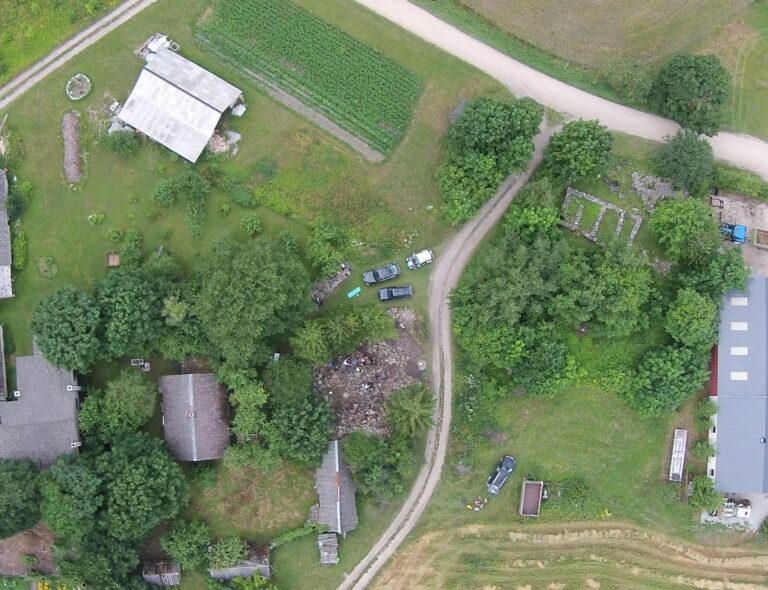
The third layer yielded the most findings which were, however, distributed unevenly: most were found in three locations. These were predominantly potsherds, some of them ornamented, from the 6th to 10th centuries, and a few metal items from the same period. Plenty of animal bones were found alongside the potsherds, but the first uncremated human bones were unearthed at the end of the second year when the fourth layer was opened.
The fourth layer had its stone wall foundation completely brushed clean during the excavations. The northern and southern sides revealed clearly marked entrances. Possible additional entrances were located on the western and northeastern sides. The northeastern entrance was connected to the aforementioned hollow. The presumed western entrance was marked by a zone yielding the largest number of findings. Potsherds and animal bones hid inside the loose soil in the layer of head-sized stones, suggesting the location of a decayed wooden construction. In any case, the ceramics containing food, and probably drinks, had crashed with the wall.
Another area with a smaller amount of findings was located near the entrance on the south side, a likely locus of a wooden post, seeing as it was surrounded by a regular ring of fallen stones over an area 40 cm wide, with only a handful of limestone rubble from the top layer. Along with other finds, fragments of human skull and teeth were retrieved. The 14C analysis placed them in a much earlier period than the rest of the findings, either the end of the Bronze Age or the beginning of Pre-Roman Age.
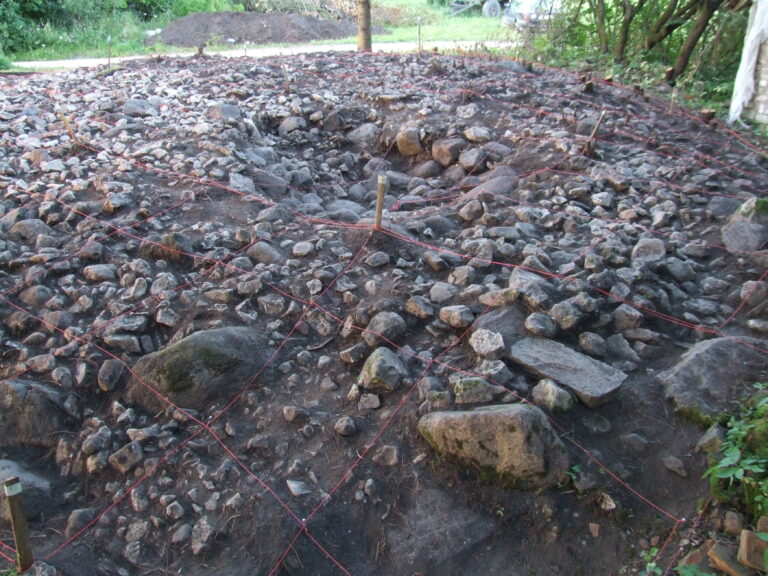
The second putative posthole appeared on the western side of the area of concentrated finds at the eastern edge of the pit. The third posthole was in the middle of the pit, near the larger stones. Furthermore, a row of head-sized stones was unearthed in the middle of the pit, marking a belt of smaller limestones. This may have been a wall or a dent left by a fallen and decayed log, later filled with small limestones from the top layer. On the southwestern edge of the central area, the rubble also formed a clear-cut line almost transverse to the aforementioned belt, fringing the pit’s central part which displayed quite a dissimilar layer of stones.
The large granite stones in the middle of the pit did not form a distinct structure – though it cannot be ruled out completely. The stones rested upon a layer composed of tightly set small limestones, while some had slipped from their original positions. It was only along the northwestern line of the central part that the large stones formed a more clear-cut zone running parallel to the aforementioned belt, or the putative imprint of a log. Quite possibly, an area in the centre of the pit, measuring 3 x 4 metres, had been surrounded by a fence or barrier, or else hosted a partly wooden structure.
Right in the middle of the area, amongst the large stones and next to another possible posthole, was the third concentration of findings. In addition to ceramics from the 6th–10th centuries, and animal bones, some uncremated human bones were dated to the same period as the cranium fragments found in the vicinity of the previous posthole. However, the horse tooth from the same area was dated to the 5th–6th centuries. It is not too far-fetched to conclude that these human bones were brought there from somewhere else during some ritual, either in the Middle Iron Age or Viking Age.
Excavations also unearthed two burials from different periods. The central area of the pit revealed a low barrow 5–6 m in diameter and densely covered with limestone shingles. In the middle of the barrow lay a human skeleton placed upon and covered with larger limestone slabs. The head was directed to the north-east and the grave was void of artefacts. The deceased was a 20–30-year-old male with his bones preserved in a fragmentary state. The length of the skeleton was measured in the grave and found to be 160 cm, however, judging by the femoral head, the calculated body height was approximately 178 cm and the body weight around 73 kg. The 14C analysis dated the burial to the period between 1005 and 836 BC. Seeing as from this period, only mixed burials within clearly defined stone structures, like stone cist graves, or the tarand-graves of Kurevere type, had hitherto been discovered in Saaremaa, the Saunamäe burial can be considered extraordinary. It is also clear that, if ever found, this type of burials may easily go unidentifed as hailing from the Bronze Age.
The other burial belonged to a later period, when this site was still in use. In the southwestern corner of the complex, against the surrounding stone wall, an arch made of bigger stones was detected. It resembled the circular wall of the Viking Age stone circle graves. Inside the circular wall were large granite stones with limestones in between, along with a small amount of burnt bones and some heavily scorched fragments of bronze items. These, as well as the construction, indicated a cremation burial in a stone circle grave from the early Viking Age.
The data collected so far suggest the following evolution of the complex. In the Bronze Age, a low, modest limestone barrow was erected to contain the burial of a local high-status individual. Maybe the area was kept clean of grass and weeds. Anyhow, it must have survived in people’s memory even 1500 years later when a shrine was raised in the same place. Offerings were taken to the shrine, and continuity and connection with the ancestors were demonstrated through the human bones brought from somewhere else.
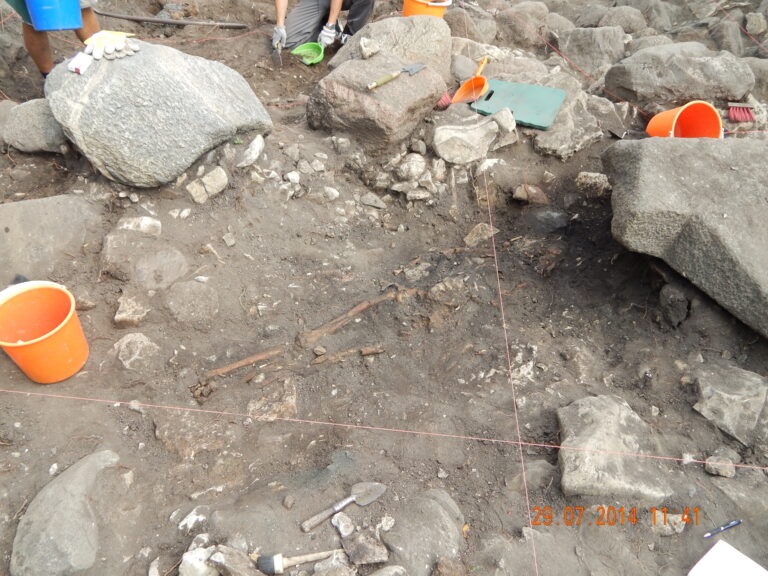
At about the same time, a massive stone wall was built around the central shrine. It was probably 150–160 cm high and encompassed a 9 x 9 m area. Later, most likely at the beginning of the Viking Age, another cremated individual was buried in the complex, in a stone circle grave erected in one corner.
Saunamäe formed one complex with Tuulingumäe some 20–30 km away at Tõnija, as determined by the post-excavation 14C analysis showing that, similarly to Saunamäe, the Tuulingumäe tarand-grave contained human bones brought from someplace else. Based on the grave goods, however, some burials at Tuulingumäe must have hailed from the same era as the tarand-graves dated to the 5th–6th centuries. Scarce in finds, the Tuulingumäe cult site, previously dated to the Late Bronze Age or Pre-Roman Iron Age based on certain stratigraphic lines, was after radiocarbon testing shown to be a contemporary of Saunamäe. There, too, the later finds and some ceramics could be dated to the Viking Age. The Tuulingumäe stone platform probably carried a wooden construction as indicated by an even burnt layer. A radiocarbon analysis placed the fire in the 14th–15th centuries. Although not unlikely that such a late dating is due to a random medieval fire, it is nevertheless consistent with the 14C samples from the Lepna mortuary house situated barely 1.2 km away, confirming that the last fire before the house’s collapse was made in the 13th or 14th century. Whether the walls and other parts of the Saunamäe shrine were maintained until then, or whether they fell into ruin earlier, is unknown.
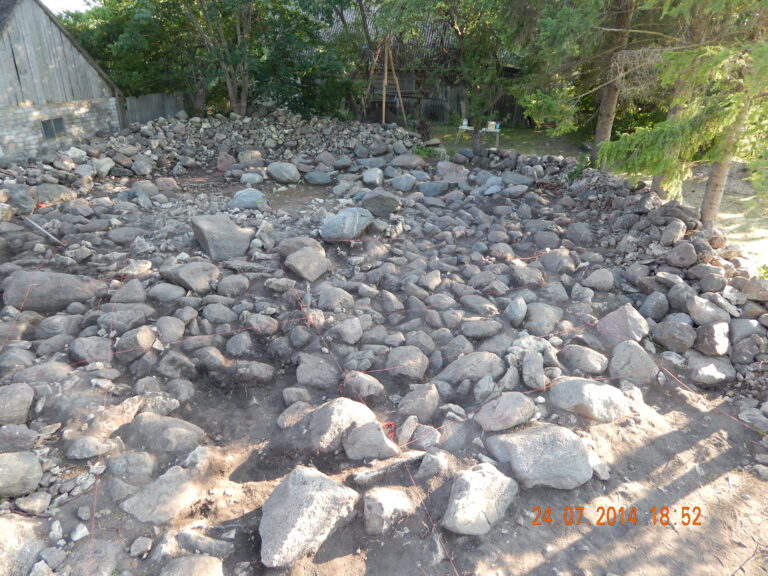
The Tõnija cult complex has many parallels in the eastern part of Middle Sweden, where most of these sites were excavated in the 1990s and 2000s. The Lunda cult site in Södermanland was, similarly, built of stones and contained stone circle graves. Findings, mostly potsherds and some human bones, dated its most intense use to the 6th–7th centuries. Some 150 metres from the cult site was a log construction, a partly open wooden cult building with a stone platform inside. A cult building with a stone foundation discovered in Sanda in Uppland seems to bear an even greater resemblance to Tuulingumäe. Dated primarily to the 6th–7th centuries, it contained an indoor platform composed of smaller stones and was open on one side, much like Tuulingumäe and many other known cult buildings. Last but not least, mention should be made of the cult site of Lilla Ullevi in Uppland, which is dated to the 7th–8th centuries and contains a stone platform mimicking a longhouse.
Another Viking Age analogue to Tuulingumäe in particular can be found in Strazde, northern Courland, a site featuring ten pits probably used for sacrificing. Also, a stone construction broadly resembling that of Saunamäe has been excavated at Tansi-Jaani barely 7 km from Tõnija, and roughly dated to the Roman Iron Age.
What is remarkable about the Tuulingumäe and Saunamäe complex is that the shrines were contained in a very limited area and were thus hardly designed for large gatherings. Rather, small sanctuaries like these indicate rituals carried out by selected individuals, either clan leaders or shamans. However, the Viidumäe sacrificial site discovered in 2014 demonstrates that not all cult sites in Saaremaa were small, restricted spaces. It is probably not without importance either that all the cult sites discussed here are located in the coastal areas around the northern half of the Baltic Sea. This is the same area where a shared cultural sphere began to take shape in the Pre-Viking age.
